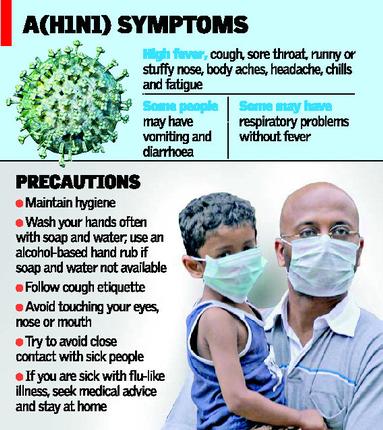Bangalore, September 25: The panic over influenza A(H1N1) may have subsided but the virus is still in the air. As many as 12 deaths have been reported in the State from January till date. Although this number is much less compared with the 135 deaths reported during the first outbreak in 2009, doctors said it was important to take precautions.
According to an official statement released by the State Health and Family Welfare Department, 5,420 of the 29,990 samples have tested positive for the virus from 2009 till date. A total of 331 people have succumbed to the infection during this period. Of these, 12 deaths, including three in Bangalore, were reported this year (from January till date). Two deaths, including one from Bangalore, were reported in the last fortnight alone.
Officials of the Health Department are on an alert following this. Health Director B.N. Dhanya Kumar told The Hindu that the department initiated surveillance measures in July itself. “With the fluctuating weather — rain and the continuous drop in temperature — cases of A(H1N1) are being reported from across the State,” he said.
Influenza A(H1N1) was the biggest medical story of 2009 that kept the State’s health machinery busy all through the year. While 135 A(H1N1) deaths were reported in 2009, 120 people died in 2010. The deaths came down to 16 in 2011 and rose to 48 in 2012.
The number of confirmed (positive) cases rose from 1,799 during the 2009 outbreak to 2,552 in 2010. In 2011, this number came down to 108 and again rose to 878 in 2012. This year, only 83 people have tested positive.
According to medical experts, the influenza (A) virus is known to mutate and a new virus erupts every time there is a mutation. The spread of the infection depends on the nature of the virus, and the World Health Organization (WHO) is studying the mutations.
Dr. Dhanya Kumar said doctors and government and private hospitals in the districts had been directed to follow the standard treatment protocol recommended by the Centre when the outbreak was first reported in 2009. There was no dearth of medicines, he said.
‘Similar to common flu’
Director of Rajiv Gandhi Institute of Chest Diseases Shashidhar Buggi said the infection was similar to common flu. “The initial panic about the disease may not be there now because of increased awareness and availability of effective medicines,” he said.
Pointing out that the low temperature that was prevailing these days was conducive for the virus to thrive, Dr. Buggi said patients must detect the symptoms early and take precautions.

